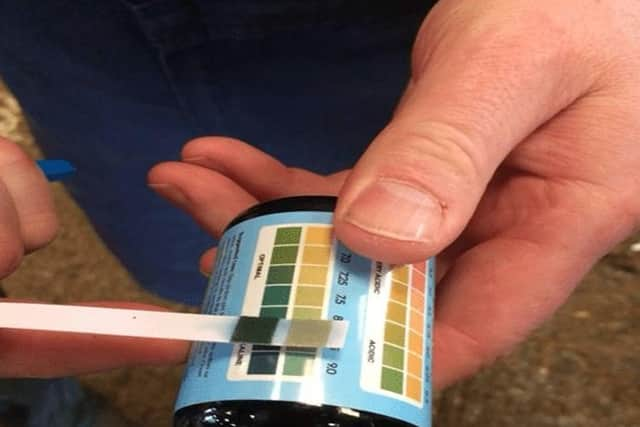Using DCAB to control Milk Fever


Transition success is defined by lack of issues such as milk fever, retained placentas and ketosis.
However, better fresh starts and higher peak yields require a focus on preventing sub-clinical issues. Assessing 4-week milk yields can be useful to help determine how cows are transitioning, with 4-week milk yields strongly linked to lactation yield. Table 1 shows 4-week milk targets for different 305-day milk yields.
Advertisement
Advertisement
This article will focus on using dietary cation-anion balance (DCAB) to help control blood calcium and successfully transition cows, however it is important to mention that management factors such as overcrowding, feed space, clean water, cow comfort and group changes are equally as important as the diet in achieving transition success.
It is easy to spot a cow with clinical milk fever, however blood calcium levels can drop below normal without showing signs of milk fever and this is called sub-clinical milk fever. For every case of clinical milk fever, there may be eight or more cases of sub-clinical disease.
Sub-clinical milk fever has effects such as:
- Reduced feed intake, increased body fat mobilisation and subsequent increased risk of ketosis
- Reduced abomasal motility increasing the risk of displaced abomasums (DAs)
Advertisement
Advertisement


- Reduced muscle contraction, which prevents teat closure after milking, therefore increasing mastitis risk
- Increased risk of retained placentas
- Reduced immunity
- Increased days to first service and reduced conception rates.
Therefore, minimising sub-clinical milk fever can have a major impact on cow performance and herd profits.
Around calving, the cow’s calcium demand increases three-fold, leaving her susceptible to sub-clinical milk fever. Your nutritionist should aim to maintain DCAB between 0 and -100 mEq/kg DM to help the cow cope with the increased calcium demand. DCAB diets decrease the dietary cations, (potassium and sodium) and increase the anions (chloride and sulphur). This creates slightly acidic blood conditions, helping the cow to mobilise calcium at calving. Diets high in cations, mainly potassium, will result in more alkaline blood, making it difficult for cows to mobilise calcium around calving, increasing risk of milk fever.
Advertisement
Advertisement
The first step is choosing low DCAB forages, such as wholecrop, maize, straw and mature grass silage which didn’t receive slurry or potash fertiliser. Silage mineral analysis will determine potassium content and DCAB value. Due to higher potassium levels in grass silage it is advisable to limit inclusion to 50% maximum (<6kgDM) in dry cow diets of high yielding herds. Chopped wheat straw is an excellent feed for dry cows reducing diet DCAB, while also controlling energy intake, increasing rumen fill and promoting high intakes in the fresh period.
In addition to low DCAB forages, anionic salts can also be added to the diet. They work best in TMR feeding systems, but, they cannot totally correct DCAB. Therefore, your nutritionist will aim for total diet DCAB less than 150 mEq/kg DM before adding anionic salts. The most common anionic salts to use are magnesium chloride or ammonium chloride. Ammonium chloride is a stronger anionic salt, however magnesium chloride is more palatable and also provides soluble dietary magnesium which the cow also needs to control milk fever. Your nutritionist will adjust the amount of anionic salts to reach a diet DCAB of between 0 and -100 mEq/kg DM. Be careful not to overfeed more anionic salts as this can over acidify cows and lead to a reduction in dry matter intake.
For cows on full DCAB diets, urine pH can be measured to check how acidified the cows are after three days on the diet (target a urine pH between 5.9 and 6.8). Ensure cows receive the close up DCAB diet for at least 28 days, considering that your gestation length may only be 274 days.
Summary
- Clinical and subclinical milk fever have significant impacts on herd health
- DCAB helps to control blood calcium
- Select low DCAB forages and add anionic salts
- Monitor 4-week milk yields
- Always consult your nutritionist